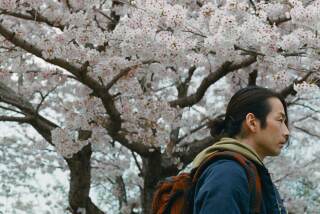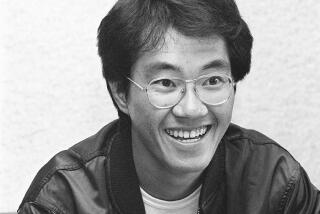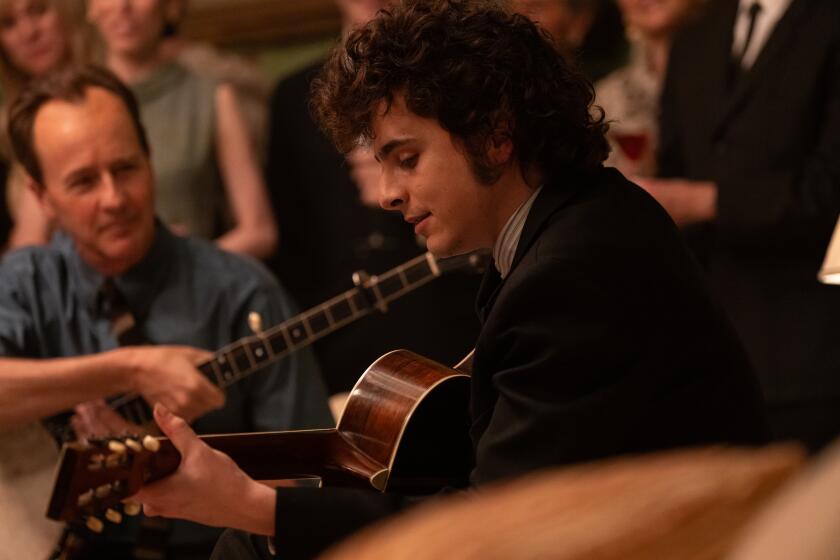Annie Awards to honor animator Katsuhiro Otomo for career achievement
- Share via
Legendary Japanese animator Katsuhiro Otomo is known around the world for his work, particularly his groundbreaking cyberpunk action feature “Akira.” But Otomo doesn’t spend time watching his own films.
“The truth is, I don’t read or watch my own creations,” Otomo says. “When I’m creating something, I’m 100% immersed in that universe, so when I’m finished, I’m ready to journey to a different world. Once a work is completed, it belongs to the readers and viewers.”
One of the most influential artists working in animation today, Otomo will receive the Winsor McCay Award for career achievement at the Annie Awards on Saturday. Frank Gladstone, president of the Assn. Internationale du Film d’Animation, or ASIFA, said that “for the board, it was an easy decision to present Mr. Otomo with the McCay Award: His influence and achievements have been consistent and unparalleled.”
PHOTOS: Celebrities by The Times
Best known as the director of the 1988 manga classic “Akira,” Otomo, 59, talked about his work via email from Tokyo last week. The McCay trophy follows the prestigious Medal with Purple Ribbon he received from the Japanese government last year; in 2005, the French government conferred the title of Knight of the Order of Arts and Letters.
“I’m honored to receive such a fabulous award,” Otomo said about the McCay honor. “But I don’t think about awards when I’m working.”
Otomo was fascinated by movies as a teenager, sometimes traveling three hours by train to see films that didn’t play in his rural home town. “When I was in high school, I had a vague idea of wanting to become a manga artist or a movie director,” he recalled. “Having grown up in the countryside, I had no idea how to enter such an occupation. But I knew that to begin, I had to move to Tokyo.”
Otomo arrived in Tokyo after graduating high school in 1973, and he quickly established himself as a writer, manga artist and animation-character designer. In 1983, he began “Akira,” a dark, sprawling epic that ran as a serial for eight years.
PHOTOS: Behind-the-scenes Classic Hollywood
In 1988, Otomo directed and co-wrote the animated feature of “Akira,” the film credited with creating a mass audience for Japanese animation in America. “Akira” is set in 2019, 31 years after Tokyo was destroyed during World War III. The glittering skyscrapers of Neo-Tokyo loom over a grimy under-city, where brutal military officers subject Tetsuo, the weakest member of a teen-age biker gang, to biomedical experiments that go terribly wrong.
Roland Kelts, the author of “Japanamerica: How Japanese Pop Culture Has Invaded the U.S.,” said that “Otomo completely transformed my awareness of animation as an art form. I first saw ‘Akira’ when I was in college. I remember talking about it for hours with three other friends who were similarly shaken by Otomo’s vision and techniques, and by his seamless blend of spiritual psychosis and institutional corruption. He is one of a handful of Japan’s, and the world’s, greatest living animators, and his art continues to expand the boundaries of visual expression.”
Although he’s identified with the brooding “Akira,” Otomo’s work encompasses a wide spectrum of moods, graphic looks and subjects. He drew and wrote the charming manga “SOS! Tokyo Metro Explorers,” about a group of schoolboys searching for lost treasure under the modern city. He wrote and directed the lavish Victorian Steampunk adventure “Steamboy,” and wrote the screenplay for the action-comedy “Roujin Z,” in which a group of feisty senior citizens hijack a military robot.
BEST MOVIES OF 2013: Turan | Sharkey | Olsen
“I don’t try to make my viewers or readers like something,” Otomo said. “I think my works that receive praise show exactly that. They’re pieces I thought were intriguing — I was fully alive in those worlds. I don’t know exactly what the Japanese audience — or another country’s audience — is feeling, but I don’t believe that everyone who goes to movies goes to see a happy ending every time. If everyone was happy, movies and entertainment would be unnecessary.”
Last year, Otomo completed “Short Peace,” an animated anthology that includes four segments by different directors. His segment, “Combustible,” a tale of Edo-period star-crossed lovers in the 18th century, styled after antique woodblock prints, made the short list for the Oscar for Animated Short Film last year. Shuhei Morita’s segment, “Possessions,” in which a samurai faces the angry spirits of umbrellas and other objects that resent being abandoned by humans after years of faithful service, is nominated in the same category this year.
Otomo declines to comment on the prospect of a live-action remake of “Akira,” a project that’s been kicking around Hollywood for more than a decade: “I illustrated the manga then directed the animated film: I will not be involved a third time.” But he’s directed one live-action movie, an adaptation of Yuki Urushibara’s supernatural manga “Mushishi,” and would like to do more,
“I would love to make live-action films, but have not had many opportunities. I’d have to start by finding trustworthy staff, which is very difficult. But I will do it. I’m thinking of making a live-action film next.”
More to Read
Only good movies
Get the Indie Focus newsletter, Mark Olsen's weekly guide to the world of cinema.
You may occasionally receive promotional content from the Los Angeles Times.









